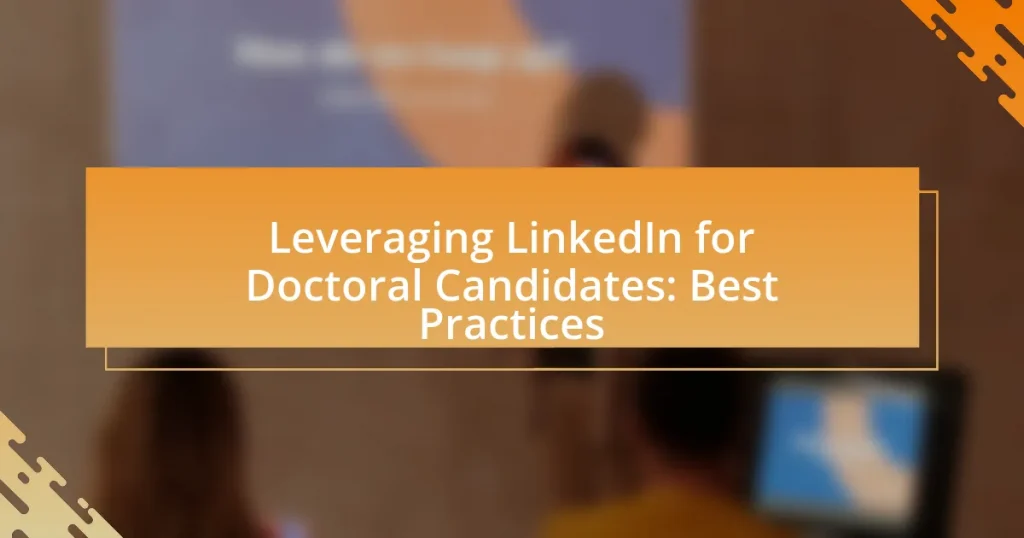The article focuses on leveraging LinkedIn as a vital tool for doctoral candidates to enhance their professional visibility, network with academics and industry professionals, and showcase their research expertise. It outlines the importance of maintaining a strong LinkedIn profile, which includes key elements such as a professional photo, compelling headline, and detailed summary of academic achievements. The article also discusses strategies for optimizing LinkedIn presence, engaging with relevant content, and connecting with potential mentors, emphasizing the platform’s role in facilitating career opportunities and collaborations within the academic community. Additionally, it highlights best practices for maintaining an active LinkedIn presence and the significance of endorsements and recommendations in establishing credibility.

What is Leveraging LinkedIn for Doctoral Candidates?
Leveraging LinkedIn for doctoral candidates involves utilizing the platform to enhance professional visibility, network with academics and industry professionals, and showcase research expertise. Doctoral candidates can create a comprehensive profile that highlights their educational background, research interests, and publications, which can attract potential collaborators and employers. According to a survey by Jobvite, 87% of recruiters use LinkedIn to find candidates, underscoring the importance of maintaining an active and engaging presence on the platform. By joining relevant groups and participating in discussions, doctoral candidates can further establish their authority in their field and connect with like-minded professionals.
How can LinkedIn be a valuable tool for doctoral candidates?
LinkedIn can be a valuable tool for doctoral candidates by providing networking opportunities, access to job postings, and a platform to showcase research and academic achievements. Networking on LinkedIn allows doctoral candidates to connect with professionals in their field, including potential mentors, collaborators, and employers, which can lead to academic and career opportunities. Additionally, LinkedIn features job postings specifically tailored for advanced degree holders, making it easier for candidates to find positions that match their qualifications. Furthermore, candidates can create a professional profile that highlights their research, publications, and skills, enhancing their visibility to recruiters and academic institutions. According to a survey by Jobvite, 87% of recruiters use LinkedIn to find candidates, underscoring its importance in the job search process for doctoral candidates.
What features of LinkedIn are most beneficial for academic networking?
The most beneficial features of LinkedIn for academic networking include the ability to create a professional profile, join academic groups, and utilize the messaging system. A well-crafted profile allows doctoral candidates to showcase their research, publications, and academic achievements, making them more visible to peers and potential collaborators. Joining academic groups facilitates discussions and networking opportunities with like-minded individuals, enhancing knowledge sharing and collaboration. The messaging system enables direct communication with other academics, fostering connections that can lead to research partnerships or mentorship opportunities. These features collectively enhance visibility, facilitate collaboration, and promote professional growth within the academic community.
How does LinkedIn facilitate connections with industry professionals?
LinkedIn facilitates connections with industry professionals by providing a platform for networking, job searching, and sharing professional content. Users can create profiles that showcase their skills, experiences, and academic achievements, making it easier for industry professionals to discover and connect with them. The platform’s features, such as personalized connection requests, messaging, and group discussions, enable users to engage directly with professionals in their field. Additionally, LinkedIn’s algorithm suggests potential connections based on shared interests, mutual connections, and industry relevance, enhancing the likelihood of meaningful interactions. According to LinkedIn’s own statistics, over 70% of professionals report that they have successfully connected with industry peers through the platform, underscoring its effectiveness in fostering professional relationships.
Why is a strong LinkedIn profile important for doctoral candidates?
A strong LinkedIn profile is important for doctoral candidates because it enhances their professional visibility and networking opportunities. By presenting a well-crafted profile, candidates can showcase their research, skills, and academic achievements, making them more attractive to potential employers and collaborators. Research indicates that 85% of jobs are filled through networking, highlighting the significance of a robust online presence in connecting with industry professionals and academic peers. Furthermore, a comprehensive LinkedIn profile can serve as a digital portfolio, allowing candidates to share publications, presentations, and other relevant work, thereby establishing credibility in their field.
What elements should be included in a compelling LinkedIn profile?
A compelling LinkedIn profile should include a professional photo, a strong headline, a detailed summary, relevant work experience, education credentials, skills endorsements, and recommendations. A professional photo enhances first impressions, while a strong headline succinctly conveys your professional identity. A detailed summary allows for personal storytelling and highlights key achievements, making it easier for others to connect with your expertise. Relevant work experience should be listed with quantifiable accomplishments to demonstrate impact. Education credentials establish your academic background, and skills endorsements validate your competencies. Recommendations from colleagues or mentors provide social proof of your abilities and character, enhancing credibility.
How can a well-crafted summary enhance a doctoral candidate’s visibility?
A well-crafted summary enhances a doctoral candidate’s visibility by clearly articulating their research interests, skills, and professional achievements, making them more appealing to potential employers and collaborators. This concise representation allows candidates to stand out in a competitive academic and professional landscape, as it effectively communicates their unique value proposition. Research indicates that profiles with detailed summaries receive 300% more profile views and 40% more connection requests on LinkedIn, demonstrating the importance of a strong summary in attracting attention and opportunities.
What strategies can doctoral candidates use to optimize their LinkedIn presence?
Doctoral candidates can optimize their LinkedIn presence by creating a comprehensive profile that highlights their academic achievements, research interests, and professional experiences. A complete profile includes a professional photo, a compelling headline that reflects their field of study, and a detailed summary that outlines their research focus and career aspirations.
Additionally, candidates should actively engage with relevant content by sharing articles, commenting on posts, and joining groups related to their discipline, which enhances visibility and networking opportunities. They can also connect with faculty, peers, and industry professionals to expand their network and seek mentorship.
Furthermore, showcasing publications, presentations, and projects in the ‘Featured’ section of their profile can demonstrate expertise and attract potential collaborators or employers. Regularly updating their profile with new skills and accomplishments ensures that their LinkedIn presence remains current and relevant.
How can candidates effectively showcase their research and publications?
Candidates can effectively showcase their research and publications by creating a comprehensive LinkedIn profile that highlights their academic achievements and contributions. This includes listing publications in the ‘Publications’ section, providing links to full-text articles or journals, and summarizing key findings in the ‘About’ section to engage potential collaborators or employers. Additionally, candidates should share posts about their research, participate in relevant discussions, and connect with professionals in their field to increase visibility. Research indicates that profiles with detailed publications and active engagement receive more views and connections, enhancing networking opportunities.
What role do endorsements and recommendations play in a LinkedIn profile?
Endorsements and recommendations significantly enhance a LinkedIn profile by validating skills and experiences. They serve as social proof, demonstrating to potential employers and connections that others recognize and support an individual’s professional capabilities. Research indicates that profiles with recommendations receive 18 times more profile views and 36 times more messages, underscoring their importance in attracting attention and fostering networking opportunities. Thus, endorsements and recommendations are crucial for establishing credibility and increasing visibility on LinkedIn.

How can doctoral candidates engage with their LinkedIn network?
Doctoral candidates can engage with their LinkedIn network by actively sharing relevant research updates, participating in discussions, and connecting with professionals in their field. By posting articles, insights, or findings from their studies, candidates can showcase their expertise and attract attention from peers and industry leaders. Engaging in group discussions or commenting on posts allows candidates to demonstrate their knowledge and build relationships. Additionally, sending personalized connection requests to professionals and alumni can expand their network and open opportunities for collaboration or mentorship. This approach is supported by LinkedIn’s data, which indicates that users who engage regularly see a 50% increase in connection requests and interactions.
What types of content should doctoral candidates share on LinkedIn?
Doctoral candidates should share research findings, academic publications, professional achievements, and insights from their field on LinkedIn. Sharing research findings helps to showcase expertise and contributes to the academic community, while academic publications establish credibility and visibility in the candidate’s area of study. Professional achievements, such as awards or conference presentations, highlight the candidate’s accomplishments and dedication. Additionally, insights from their field can engage a broader audience and foster discussions, enhancing networking opportunities. These types of content not only demonstrate the candidate’s knowledge but also position them as thought leaders in their respective disciplines.
How can sharing research updates foster engagement with connections?
Sharing research updates fosters engagement with connections by providing valuable insights that stimulate discussion and collaboration. When doctoral candidates share their findings, they not only showcase their expertise but also invite feedback and questions from their network, creating a dynamic exchange of ideas. Research indicates that posts with informative content receive higher interaction rates; for instance, LinkedIn reports that content with relevant updates can increase engagement by up to 50%. This interaction not only strengthens professional relationships but also enhances visibility within the academic community, leading to potential collaborations and opportunities.
What are the benefits of participating in LinkedIn groups related to academia?
Participating in LinkedIn groups related to academia provides networking opportunities, access to resources, and enhanced visibility in the academic community. Networking within these groups allows doctoral candidates to connect with peers, mentors, and industry professionals, facilitating collaborations and knowledge exchange. Access to resources such as articles, job postings, and discussions on current research trends helps candidates stay informed and engaged in their field. Enhanced visibility occurs as active participation can lead to recognition among academic circles, potentially opening doors for career advancement and research opportunities.
How can networking on LinkedIn lead to career opportunities?
Networking on LinkedIn can lead to career opportunities by facilitating connections with industry professionals, potential employers, and peers. Engaging with relevant content, joining industry-specific groups, and participating in discussions can enhance visibility and credibility. According to a LinkedIn survey, 85% of jobs are filled through networking, highlighting the platform’s effectiveness in job placement. Additionally, personalized outreach to connections can result in referrals, which are often more successful than traditional applications.
What strategies can doctoral candidates use to connect with potential mentors?
Doctoral candidates can connect with potential mentors by actively engaging on LinkedIn through personalized outreach and participation in relevant groups. Personalized outreach involves sending tailored connection requests that highlight shared interests or mutual connections, which increases the likelihood of a positive response. Participation in relevant groups allows candidates to showcase their expertise and engage in discussions, making them more visible to potential mentors. According to a study by LinkedIn, 80% of professionals consider networking essential for career advancement, underscoring the importance of these strategies in building meaningful connections.
How can informational interviews be facilitated through LinkedIn?
Informational interviews can be facilitated through LinkedIn by utilizing the platform’s networking features to connect with professionals in specific fields. Users can send personalized connection requests to individuals whose expertise aligns with their research interests or career goals, clearly stating their intent to learn more about their experiences. Once connected, users can request a brief conversation, either through direct messaging or by scheduling a call, to discuss insights and advice related to their academic or professional journey. According to a LinkedIn survey, 85% of jobs are filled through networking, highlighting the effectiveness of leveraging connections for informational interviews.

What are the best practices for using LinkedIn as a doctoral candidate?
The best practices for using LinkedIn as a doctoral candidate include optimizing your profile, engaging with relevant content, and networking strategically. Optimizing your profile involves using a professional photo, crafting a compelling headline, and detailing your research interests and academic achievements in the summary section. Engaging with relevant content means sharing articles, commenting on posts, and participating in discussions related to your field, which can enhance your visibility and establish your expertise. Networking strategically entails connecting with peers, faculty, and industry professionals, as well as joining groups related to your research area, which can lead to collaboration opportunities and job prospects. These practices are supported by LinkedIn’s own data, which indicates that profiles with complete information receive 40% more opportunities than those that are incomplete.
How can doctoral candidates maintain an active LinkedIn presence?
Doctoral candidates can maintain an active LinkedIn presence by regularly sharing relevant content, engaging with their network, and participating in discussions. Consistent posting of articles, research updates, and insights related to their field keeps their profile visible and demonstrates expertise. Engaging with connections through comments and messages fosters relationships and encourages collaboration. Additionally, joining and contributing to LinkedIn groups related to their research area enhances visibility and networking opportunities. Research indicates that active engagement on LinkedIn can lead to increased professional opportunities, as profiles with regular updates attract more views and connections.
What is the ideal frequency for posting and engaging on LinkedIn?
The ideal frequency for posting and engaging on LinkedIn is three to five times per week. This frequency allows for consistent visibility without overwhelming your audience. Research indicates that posting at least once a week can significantly increase engagement, with optimal results seen when posts are made multiple times weekly. According to a study by HubSpot, companies that post 16 or more times per month receive 3.5 times more traffic than those that post less frequently. Engaging with others’ content daily can further enhance visibility and networking opportunities.
How can candidates measure the effectiveness of their LinkedIn activities?
Candidates can measure the effectiveness of their LinkedIn activities by analyzing engagement metrics such as profile views, connection requests, endorsements, and post interactions. These metrics provide quantifiable data that reflects how well their content resonates with their audience. For instance, a study by LinkedIn found that profiles with a professional photo receive 14 times more profile views and 36 times more messages, indicating the importance of visual appeal in attracting attention. Additionally, tracking the number of connections made and the quality of interactions can help candidates assess their networking success. By regularly reviewing these metrics, candidates can adjust their strategies to enhance their visibility and engagement on the platform.
What common mistakes should doctoral candidates avoid on LinkedIn?
Doctoral candidates should avoid having an incomplete or unprofessional profile on LinkedIn. An incomplete profile can lead to missed networking opportunities, as 70% of employers use LinkedIn to find candidates, according to a Jobvite survey. Additionally, using an unprofessional photo or failing to customize the headline can create a negative impression, as profiles with professional photos receive 14 times more profile views. Furthermore, not engaging with relevant content or connections can limit visibility and networking potential, as active users are 10 times more likely to receive connection requests. Lastly, neglecting to showcase research and skills can hinder opportunities, as 85% of recruiters consider a candidate’s skills when making hiring decisions.
How can oversharing or irrelevant content harm a candidate’s profile?
Oversharing or irrelevant content can significantly harm a candidate’s profile by creating a negative impression on potential employers. When candidates post excessive personal information or unrelated material, it can lead to perceptions of unprofessionalism, reducing their credibility. Research indicates that 70% of employers use social media to screen candidates, and inappropriate content can result in disqualification from job opportunities. Furthermore, irrelevant posts can dilute the candidate’s professional brand, making it difficult for recruiters to identify their qualifications and expertise. This misalignment can ultimately hinder career advancement and networking opportunities.
What are the pitfalls of neglecting profile updates and engagement?
Neglecting profile updates and engagement on LinkedIn can lead to decreased visibility and missed networking opportunities. An outdated profile may fail to attract potential collaborators, employers, or academic connections, as it does not accurately reflect current skills or achievements. According to LinkedIn data, profiles that are regularly updated receive 18 times more profile views and 36 times more messages than those that are stagnant. Additionally, lack of engagement can result in diminished credibility and relevance within professional circles, as active participation is often associated with thought leadership and expertise. Therefore, failing to maintain an updated and engaging profile can significantly hinder a doctoral candidate’s professional growth and opportunities.
What practical tips can enhance a doctoral candidate’s LinkedIn experience?
To enhance a doctoral candidate’s LinkedIn experience, candidates should optimize their profiles by including a professional photo, a compelling headline, and a detailed summary that highlights their research interests and academic achievements. A professional photo increases profile views by 14 times, while a strong headline and summary can attract potential collaborators and employers. Additionally, candidates should actively engage with relevant content by sharing articles, commenting on posts, and joining academic groups, which can expand their network and visibility in their field. Regularly updating their profile with new publications, presentations, and skills also demonstrates ongoing professional development, making them more appealing to academic and industry connections.
How can candidates leverage LinkedIn analytics to improve their strategy?
Candidates can leverage LinkedIn analytics by analyzing engagement metrics to refine their content strategy. By reviewing data such as post impressions, likes, shares, and comments, candidates can identify which topics resonate most with their audience. For instance, if a candidate notices that posts about research methodologies receive higher engagement, they can focus on creating more content in that area. Additionally, tracking follower demographics helps candidates tailor their networking efforts, ensuring they connect with relevant professionals and groups. This data-driven approach enhances visibility and fosters meaningful connections, ultimately improving their overall LinkedIn strategy.
What are the key takeaways for maximizing LinkedIn’s potential for doctoral candidates?
To maximize LinkedIn’s potential for doctoral candidates, it is essential to create a comprehensive and professional profile that highlights academic achievements, research interests, and relevant skills. A well-structured profile increases visibility to potential employers and collaborators. Engaging with academic and industry-related content by sharing insights, commenting on posts, and joining relevant groups enhances networking opportunities. Actively connecting with peers, faculty, and industry professionals can lead to valuable relationships and job opportunities. According to LinkedIn data, profiles with a professional photo receive 21 times more profile views and 36 times more messages, underscoring the importance of a polished presentation.



